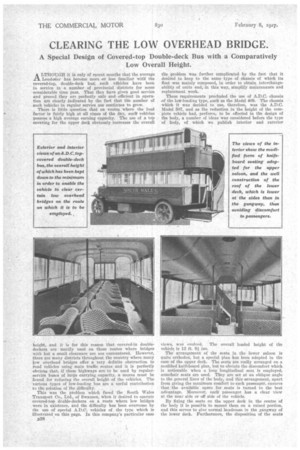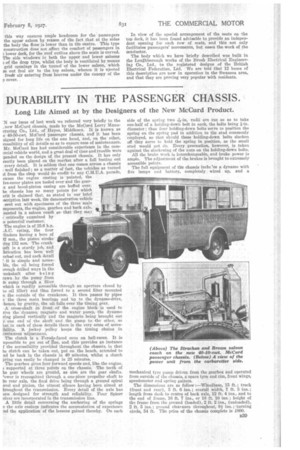CLEARING THE LOW OVERHEAD BRIDGE.
Page 136

Page 137

If you've noticed an error in this article please click here to report it so we can fix it.
A Special Design of Covered-top Double-deck Bus with a Comparatively Low Overall Height.
ALTHOUGH it is only of recent months that the average Londoner has become more cv less familiar with the Covered-top, double-deck bud, such vehicles have been in service in a number of provincial districts for some considerable time past. That they have given good service and proved they are perfectly safe and efficient in operation are clearly indicated by the fact that the number of such vehicle in regular service use continues to grow.
There is little question that on routes where the load factor is fairly high at all times of the day, such vehicles possess a high average earning capacity. The use of a top covering for the upper deck obviously increases the overall height, and it is for this reason that covered-in doubledeckers are mainly used on those routes where bridges with but a small clearance are not encountered. However, there are many districts throughout the country where many low overhead bridges offer a very definite obstruction to road vehicles using main traffic routes and it is perfectly obvious that, if these highways are to be used by regularservice buses of large carrying capacity, a means must be found for reducing the overall height of the vehicles. The various types of low-loading brie are a useful contribution to the solution of the difficulty.
This was the problem which faced the South 'Woks Transport Co., Ltd., of Swansea, when it desired to operate covered-top dcuble-deckers on a route where low bridges were in existence, and the difficulty has been overcome by the use of special A.D.C. vehicles of the type which is illustrated on this. page. In this company's particular case
038
the problem was further complicated by the fact that it desired to keep to the same type of chassis of which its fleet was mainly composed, in order to obtain interchangeability of units and, in this way, simplify maintenance and replacement work.
These requirements precluded the use of A.D.C. chassis of the low-loading type, such as the Model 400. The chassis which it was decided to use, therefore, was the A.D.C. Model 507, and as the reduction in the height of the complete vehicle had, perforce, to be effected in the design of the body, a number of ideas was considered before the type of body, of which we publish interior and exterior
views, was evolved. The overall loaded height of the vehicle is 13 ft. fli ins.
The arrangement of the seats in the lower saloon is quite orthodox, but a special plan has been adopted in the case of the upper deck. The seats are really arranged on a modified knifeboard plan, but to obviate the discomfort which is noticeable when a long longitudinal seat is employed, armchair seats are used. They are set at an oblique angle to the general lines of the body, and this arrangement, apart from giving the maximum comfort to each passenger, ensures that the available space for seats is turned to the best advantage. • Moreover, each passenger has a clear view at the near side or off side of the vehicle.
By fixing the seats on the upper deck in the centre of the body it is possible to mount them on a raised, portion, and this servos to give normal headroom in the gangway of the lower deck. Furthermore, the disposition of the seats
this way ensures ample headroom for the passengers the upper saloon by reason of the fact that at the sides the body the floor is lower than in the centre. This type construction does not affect the comfort of passengers in 3 lower deck, for the roof outline above the seats is curved. The side windows in both the upper and lower saloons 3 of the drop type, whilst the body is ventilated by means grid openings in the tunnel of the lower saloon, which as out foul air to the top saloon, whence it is ejected fresh air entering from louvres under the canopy of the p oover.
In view of the special arrangement of the seats on the top deck, it has been found advisable to provide an independent opening for each row of scats, and this not only facilitates passengers' movements, but eases the work of the con doctor.
The body which we have briefly described was built in the Loughborough works of. the Brush Electrical Engineering Co., Ltd., to the registered designs of the British Electrical Federation, Ltd. We are told that 12 buses of this description are now in operation in the Swansea area, and that they are proving very popular with residents.




































































































































































































